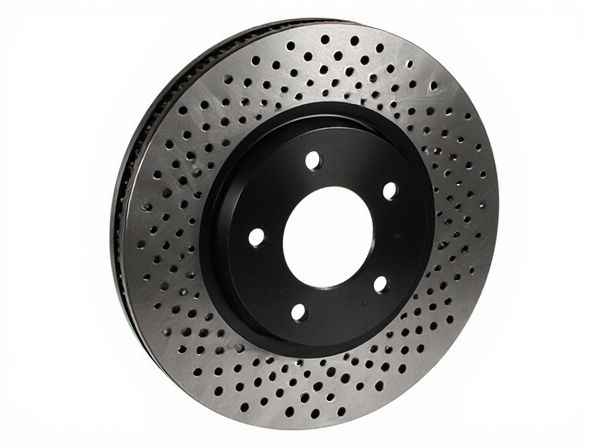
Photo illustration: Cross-Drilled Rotor vs Directional Slotted Rotor
Cross-drilled rotors improve heat dissipation and reduce brake fade by allowing ventilation through holes drilled across the rotor surface. Directional slotted rotors enhance brake bite and help expel gases and debris with their angled slot patterns, improving overall braking performance. Your choice should consider driving conditions and preferences for cooling efficiency versus debris evacuation.
Table of Comparison
| Feature | Cross-Drilled Rotor | Directional Slotted Rotor |
|---|---|---|
| Design | Round holes drilled across rotor surface | Slots angled in the direction of rotation |
| Heat Dissipation | Improves cooling by releasing heat and gases | Enhances cooling by channeling heat and debris away |
| Performance | Better for light to moderate braking | Superior for aggressive and high-performance braking |
| Durability | Prone to crack under extreme stress | Higher resistance to cracking and wear |
| Water and Debris Removal | Moderate effectiveness | Highly effective at expelling water and debris |
| Noise | May produce more noise due to holes | Generally quieter during braking |
| Cost | Usually less expensive | Typically higher cost due to complex slot design |
Introduction to Performance Brake Rotors
Performance brake rotors enhance braking efficiency through specialized designs like cross-drilled and directional slotted rotors. Cross-drilled rotors feature precision-drilled holes that improve heat dissipation and reduce brake fade under extreme conditions, making them ideal for high-performance driving. Directional slotted rotors optimize brake pad contact and expel gases and debris efficiently, resulting in consistent stopping power and improved wet-weather performance.
What Are Cross-Drilled Rotors?
Cross-drilled rotors feature holes drilled through the rotor surface to enhance heat dissipation and improve braking performance by allowing gases, heat, and water to escape more efficiently. These rotors are popular in high-performance vehicles and motorsports due to their ability to reduce brake fade under extreme conditions. However, they may be more prone to cracking compared to solid or slotted rotors, requiring careful consideration based on driving style and vehicle use.
Understanding Directional Slotted Rotors
Directional slotted rotors feature precision-cut slots that enhance brake pad bite and improve heat dissipation by channeling gases and debris away from the contact surface, reducing the risk of brake fade. Unlike cross-drilled rotors, which rely on drilled holes that can develop cracks under extreme stress, directional slotted rotors maintain structural integrity and provide consistent braking performance. These rotors are optimized for high-performance and heavy-duty applications, making them ideal for enthusiasts and vehicles subjected to aggressive braking conditions.
Heat Dissipation: Cross-Drilled vs Directional Slotted
Cross-drilled rotors excel in heat dissipation by allowing air to flow directly through the drilled holes, promoting rapid cooling during intense braking. Directional slotted rotors enhance heat dispersal by channeling gases and debris away from the pad surface, maintaining optimal friction and reducing brake fade. Comparing both, cross-drilled rotors provide superior cooling efficiency under high thermal stress, while directional slotted rotors offer improved performance in maintaining consistent brake pad contact.
Wet Performance and Debris Removal
Cross-drilled rotors excel in wet performance by allowing water to escape quickly through drilled holes, minimizing brake fade during heavy rain. Directional slotted rotors enhance debris removal and maintain consistent pad contact with angled grooves that channel dust and dirt away. Both designs improve braking efficiency, but directional slots generally offer superior debris evacuation and wet traction under demanding conditions.
Brake Fade Resistance Comparison
Cross-drilled rotors provide enhanced heat dissipation through perforations that improve ventilation and reduce brake fade by allowing gases and heat to escape quickly. Directional slotted rotors feature angled grooves designed to channel away dust, water, and gas buildup more efficiently, maintaining consistent brake pad contact and minimizing fade during prolonged braking. In terms of brake fade resistance, directional slotted rotors typically offer superior performance under heavy braking conditions due to better debris expulsion and sustained friction levels.
Lifespan and Durability
Cross-drilled rotors feature holes that enhance cooling and brake fade resistance but can be prone to cracking, potentially reducing lifespan under aggressive driving conditions. Directional slotted rotors have non-drilled grooves that improve debris and gas evacuation while maintaining structural integrity, resulting in longer durability and consistent performance. For extended lifespan and durability, directional slotted rotors offer superior resistance to thermal stress and cracking compared to cross-drilled designs.
Noise and Vibration Differences
Cross-drilled rotors feature precision-drilled holes that improve heat dissipation and reduce brake fade but tend to generate higher noise and vibration due to air turbulence and uneven pad contact. Directional slotted rotors, designed with angled slots to channel gases and debris away, provide smoother braking with lower noise and vibration levels by maintaining consistent pad engagement and reducing brake judder. Studies show directional slotted rotors offer superior NVH (Noise, Vibration, Harshness) performance, making them preferable for drivers prioritizing quiet and refined braking experiences.
Suitability for Street vs Track Use
Cross-drilled rotors provide excellent heat dissipation and improved braking performance, making them suitable for street use where occasional spirited driving and wet conditions occur. Directional slotted rotors excel in track environments by efficiently channeling gases and debris away, maintaining consistent brake performance under high-stress conditions. Street drivers benefit from the quieter, less abrasive wear of cross-drilled rotors, while track enthusiasts prioritize the enhanced stopping power and durability of directional slotted rotors during aggressive braking.
Choosing the Best Rotor for Your Driving Needs
Cross-drilled rotors excel in heat dissipation and performance during high-speed braking, making them ideal for sporty driving and track use. Directional slotted rotors enhance debris removal and maintain consistent braking under heavy, real-world conditions, suitable for everyday driving and towing. Selecting the best rotor depends on prioritizing performance needs--cross-drilled rotors for aggressive driving and directional slotted rotors for durability and reliability in daily use.
 caratoz.com
caratoz.com